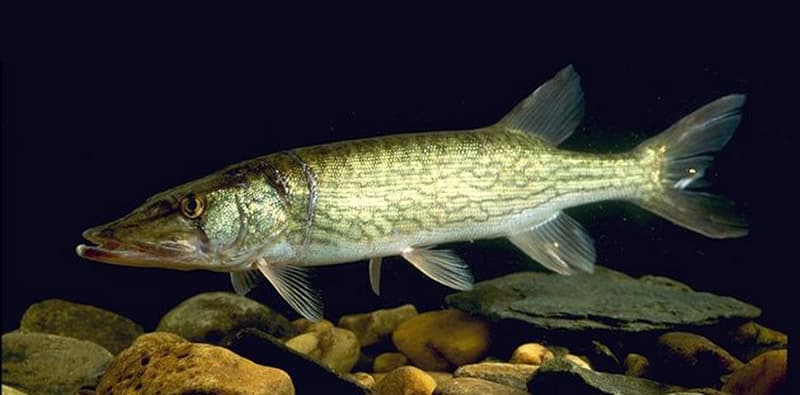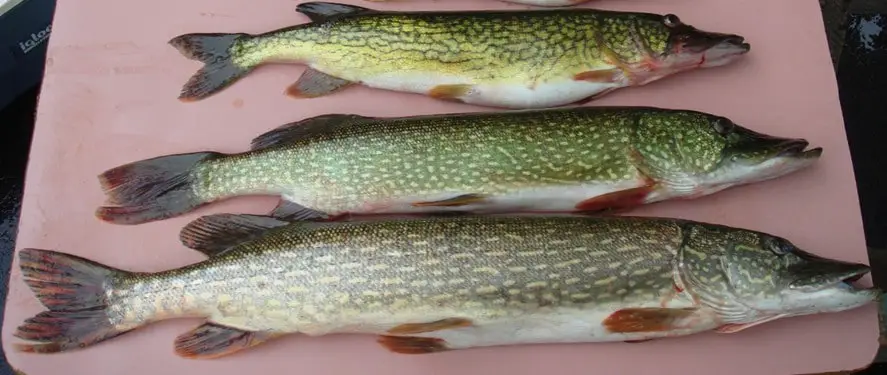Pickerel are a member of the Esox family, known by anglers as the pike family. This includes the chain pickerel, grass pickerel, and redfin pickerel, with only the chain pickerel likely to ever be mistaken with a northern pike.
These fish are well known for their tough fight even at smaller weights and are enjoyed by many anglers. Though many practice catch and release because if you don’t know how to deal with the Y-bone as you would with a pike, the fillets tend to be bony.
So let’s take a quick look at this smaller group of fish in the Esox family and how they compare and contrast to their larger cousins…as well as maybe a bit of advice on how to go fishing for them.
Three Types of Pickerel
When you look at pickerel, they are the smaller members of the Esox family of fish, but they remain popular in many areas they live as an exciting sports fish that puts up a great fight pound for pound.
Or in the case of the redfin, usually ounce for ounce.
But fun fishing is fun fishing, and the pickerels do their older cousins proud in that regard.
Chain Pickerel
This is the most widespread of the pickerel through the United States and the one most often mistaken for northern pike as these fish look quite alike at first glance.

Chain pickerel are a popular game fish because they put up a great fight and hit a lure with enthusiasm. You don’t have to guess when a chain pickerel hits the lure, you just need to set the hook.
This fish is also locally called a grass pike, Jack, Jackfish (although that nickname truly belongs to the far north northern), eastern pickerel, and even the southern pike.*
These fish are very common in the Midwest states and the South on the Atlantic side, and can be found throughout large swaths of the Mississippi River basin, as well.
*Not to be mistaken with the actual southern pike, a relatively new pike species found in a limited zone in Europe.
Size
The world record catch for a chain pickerel is over 60 years old and comes out of Georgia – weighing in at an incredible 9 lbs 6 oz. The far majority of pickerel caught by anglers are in the 2-3 lb range.
Appearance
The chain pickerel shares a lot of characteristics with its northern pike cousin, and lakes sharing large populations of both have even produced pike-pickerel hybrids.
Featuring dark green body with bright lighter green specks and dashes across the side, with a sharp finned tail more like the muskie than the pike.
Fishing Tactics
Chain pickerel are very aggressive in their weedy and shallow water haunts, so any tactic you would use on northern pike or the largemouth bass also likely to thrive in the area would also
- Lures that do well with local bass will do well with pickerel
- Lures like spinners, plugs, and surface spinners do well
- Lures that agitate will do well
- Some angler friends of mine down south recommend a Texas rig if you’re putting plastic lures around the weeds
- Look for weeds and shoreline – they are ambush predators like the northern pike
Chain Pickerel-Northern Pike Hybrids
Like most hybrids that occur in nature the pickerel-pike hybrid is sterile. They combine the features of both fish but because the overlap of areas where pike and pickerel are, and the fact the hybrid isn’t clearly comparable as a sports fish to both its parents (unlike the tiger muskie), there isn’t a widespread hatchery program for these fish.
When you catch one it can be very hard to identify as they blur the already similar appearances that pike and pickerel share.
Scroll down to the FAQ to see the picture of a pickerel, a pike, and a hybrid together to see what I mean. The hybrid is the one in the middle, and it could easily be mistaken for a full blooded northern pike.
They aren’t common – but they’re fun fighters when you do manage to set that hook!
Grass Pickerel
The grass pickerel is one of the smallest members of the pike family, and along with the redfin pickerel is one of two “American Pickerel” fish. In fact, “little pickerel” is one of the nicknames of this fish, along with mud pickerel, banded pickerel, and small red-finned pike.
Size
The grass pickerel is one of the smallest pickerels out there. The world record is a mere 2 lbs 10 oz with many state records right around the 2 lb mark. While related to the much larger fish in the pike family, no one is going to mistake a grass pickerel for their larger cousins.
Appearance
Grass pickerel are extremely dark in appearance, with lighter bar patterns on the top. They are extremely closely related to the redfin pickerel to the point where sometimes they are talked about interchangeably (as this site shows).
They are small fish that can still be fun when using ultralight gear.
Fishing Tactics
Not many anglers are going to go after these small fry but if you insist go with ultralight rod, lightweight lure mimicking a bug (similar to flies or maybe a light spinner bait) and 2 to 4 lb test line.
That’s how you have the most fun.
- All gear should be lightweight
- Hit those reedy areas
- Watch that rod bend over double if you hook a decent sized chain pickerel
Redfin Pickerel
The smallest of the pickerel, the redfin is the most likely one that you haven’t heard of. There’s good reason for this. Not seen as much of a sports fish, the redfin pickerel’s world record is 2 lbs 10 oz and that’s an aberration with how big it is.
The average redfin pickerel is only 6-10 inches in length. Anything above 11 inches is considered a really good one.
Appearance
A redfin pickerel has very light skin with dark bars, the opposite of the grass pickerel. They have an elongated head.
The name is accurate as their fins have a distinctive red or orange coloration that sets them apart from other pike and pickerel.
Fishing Tactics
Ultralight gear and tackle. In all likelihood you’re almost certainly fishing for something else when you end up hooking one of these.
Take a picture and then release.
Pickerel FAQ
Q: Are pickerel good to eat?
A: You do need an experienced angler who knows how to properly clean and debone them. As long as you have that to get clean fillets that aren’t stuffed with ribs, then pickerel tastes delicious.
Q: Is pickerel the same as pike?
A: No. Although the fish all belong in the same family, they are not the same fish. Though if you’re in an area with big chain pickerel this can be confusing as the chain pickerel vs. pike identification can prove challenging to less experienced anglers.
And maybe even to very experienced ones if you’re in a lake with pickerel-pike hybrids, as pictured below.

Q: Do pickerel bite humans?
A: No. You may get a hook in the hand if you’re not careful, but pickerel are not going to attack a person. While there are a few recorded incidents of muskies attacking people, these are fairly rare and because the muskie misidentified a body part as prey, then letting go immediately upon realizing they bit something too big to eat.
Q: Why is walleye called pickerel?
A: This seems to be something that comes up in only a couple really specific areas where a pike is a pike and a walleye is a pickerel. Or a yellow pickerel. For some reason.
Despite multiple phone calls and a lot of research, there doesn’t seem to be a clear story of why this is the case.
This seems to be most common in certain sections of Canada, particularly Saskatchewan and areas near the border of that territory in neighboring provinces.
In Conclusion
While it can seem weird that fish of such a different size and in most cases, appearance, could be related but that is exactly the case here.
While only one of these pickerel is generally considered a heavy duty freshwater sports fish, these smaller members of the pike family know how to put up a fight.
And if you’ve been fishing for a couple hours you’ll welcome that feeling when a pickerel smashes into your lure looking for its next meal.
While they might not get the attention or love of the northern pike or the muskellunge, pickerel can lead to a fun afternoon of local fishing.
And if you have an angler in the group who can expertly debone them, some dang good eating, as well!
